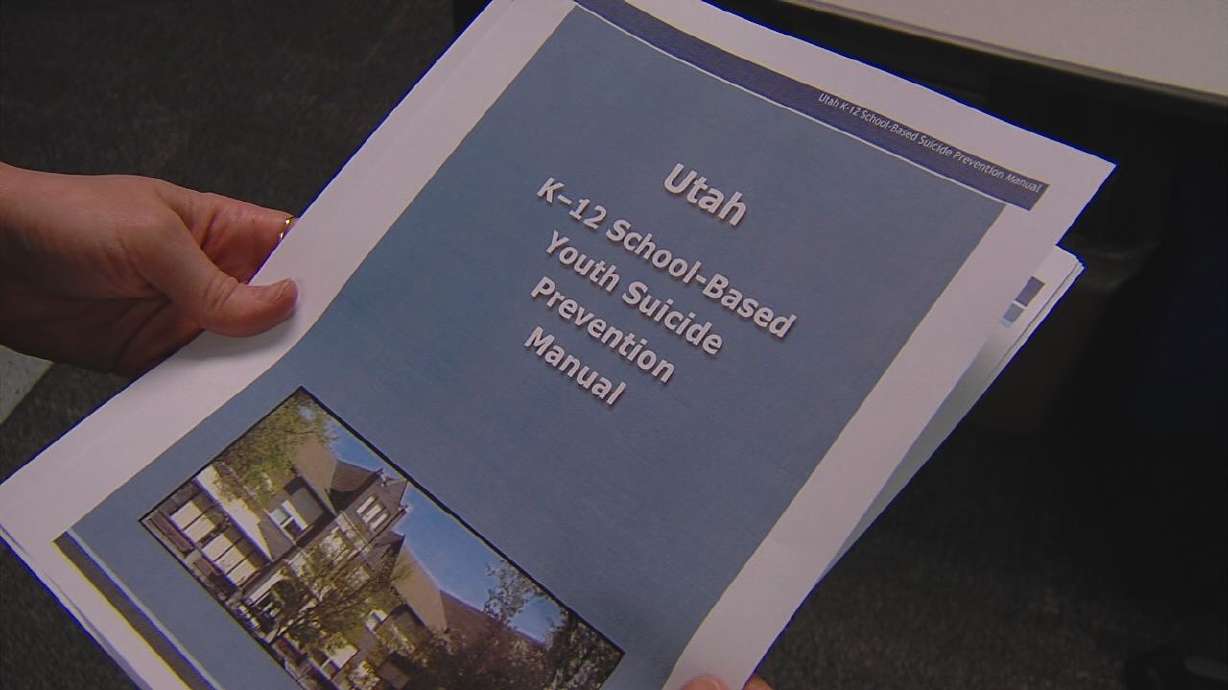Estimated read time: 4-5 minutes
This archived news story is available only for your personal, non-commercial use. Information in the story may be outdated or superseded by additional information. Reading or replaying the story in its archived form does not constitute a republication of the story.
MOUNT PLEASANT, Sanpete County — Utah has one of the highest suicide rates in the country, especially among young men. The startling numbers are prompting educators across the state to step up in search of solutions.
Generally, news agencies like KSL do not report suicides because we don't want to glorify or draw attention to these deaths. But we believe this is an important topic that needs to be addressed more consistently in our communities.
- Suicide is the second leading cause of death for Utah males ages 10-44
- Four times as many males as females commit suicide — more females attempt than males
- 65% of Utah male youth suicide completers had been diagnosed with a psychiatric disorder such as depression
- 63% of Utah male youth suicide completers had contact with the juvenile justice system
- 16% of Utah high school students said they seriously considered attempting suicide; 14% made a plan of how they would attempt suicide
Source: Utah HOPE Task Force
In Mount Pleasant last year, one man's choice to end his life would make 18-year-old Tyler Johnson feel like that was the only way he could end his own battle with depression.
"And then his death influenced my other friend to do it, but she didn't actually succeed," said Morgan Johnson, Tyler Johnson's younger brother.
Pain doesn't end with suicide. It is passed on to family and friends. Morgan Johnson is still trying to make sense of his brother's senseless death.
"I have my days where I get sad and depressed and I'll cry, but most of the time I'm good about it," he said.
Since Tyler Johnson's death, Morgan Johnson and his family have worked hard to raise awareness and hope. They organized a 5K race, invited experts to speak to the community about suicide, and held a vigil in January.
"My goal is to try and let people know (suicide) is not the way out, and you can get help," Morgan Johnson said.
In 2011, at least 14 people living in the boundaries of the North Sanpete School District took their own lives. The impact is particularly tough here in light of the tight-knit communities where nearly everyone can feel the effects of suicide."
"No, we are not exaggerating to say it has hit the community hard," said Michael Blair, a marriage and family counselor in the area.
In the Deseret News:
"It sends the entire community into a mode of grieving," said Leslie Keisel, superintendent of the North Sanpete School District.
Keisel said found people were reluctant to talk about suicide, even after four people killed themselves during a three-week period in December and January.
"If we as adults are not willing to talk about it even when it happens, how do we expect our children to talk about it?" Keisel said.
Utah sits right in the middle of the suicide belt, which stretches along the Rocky Mountains. One of the prevailing theories for the higher rates of suicide is the states in this area have more rural areas, and families have less access to mental health support.
"In this rural county of, oh, say 25,000, people there are very limited in resources, in terms of even a therapist available," Blair said.
To help begin a healthy dialogue about suicide, Keisel asked the state's leading prevention expert — Provo School District's director of student services, Greg Hudnall — to come down and speak to teachers, faculty and community leaders.
"We don't understand at what point someone gets to the point where suicide becomes an option," Hudnall said. "What we can do is we can understand the signs." Suicide prevention became a personal mission for Hudnall when, as a new principal in Provo, he had to identify the body of a student who killed himself.
HOPE Task Force resources
- Education for community and groups: Presentations that increase education, awareness and provide prevention information. Call 374-4802 for more information
- Survivor group: Group meets monthly. visit groups.msn.com/heartandsoulsuicidesurvivors.
Crisis Hotlines
- Utah County Crisis Line: 801-226-4433
- Wasatch Mental Health Crisis Line: 801-373-7393
- National Crisis Line: 1-800-784-2433
- Trevor Project Hotline for LGBTQ teens: 1-866-488-7386
Online resources
- NAMI Utah: namiut.org
- Salt Lake Mental Health: saltlakementalhealth.com
- Utah Chapter-American Foundation for Suicide Prevention: afsputah.com
- North Sanpete County: blaircounselingandlifestar.com
"I remember thinking, how could such a handsome young man with so much potential in this life not want to live anymore," Hudnall recalled.
Following the experience, he organized the HOPE Task Force for suicide prevention. "We didn't want to be a therapy, we just wanted to educate and provide help on where to get help," he explained.
The task force also includes a HOPE squad: a comprehensive peer mentoring program. "It's not just helping people avoid suicide, but it's helping people avoid depression," said Adriana Ojuka, a sophomore participating in the program.
The overall impact of the HOPE task force is remarkable. The Provo School District used to average one to two suicides a year; it's now going on its seventh year without a suicide.
Hudnall has used this model to write Utah's first statewide suicide prevention plan for schools, which will go online in the fall of 2012. Administrators like Keisel will welcome the additional resource.
"I think we need to do more in our schools and in our health programs," Keisel said.
While people may fear talking about suicide, those discussions may ultimately save a life.
"We need to talk about it, and suicide needs to stop," Morgan Johnson said.
Until it does, more brave voices need to come forward and break the silence of suicide.










